Immigration And Naturalization Service
-
- The Irony Of Maritime Security Maritime Reporter, Nov 2002 #18
now appears that the 107th United States Congress will enact new maritime security legislation during a lame-duck session to be held this month. This is ironic since both Senate and the House of Representatives passed maritime security bills months ago, the two measures were largely similar, and the two houses have been conferencing on development of a joint measure for some time. The purpose of this paper is not to dwell on the issues that delayed earlier passage of the measure. Rather, it is to review what new maritime security measures have been adopted by the various federal agencies utilizing their existing authority.
As with the beginning of U.S. involvement in WW II and the Korean War, the War against Terrorism has started out as a 'come as you are' event. While Congress has passed supplemental appropriations bills, it has been noticeably slow in enacting new legislation intended specifically to provide new legal tools to reduce the risk of maritime terrorism in the United States. As the world saw on October 6, 2002 with the terrorist attack on the French supertanker Limburg in Yemen, the maritime security threats are very real and can take many guises.
Thus far, the majority of actions taken by the federal agencies charged with maritime security missions have been undertaken utilizing old statutory authority. Some measures (including some that have generated controversy), though, have been undertaken utilizing little-noticed provisions found in recent legislation.
Old Tools The U.S. Coast Guard's broad port security authority dates from the Espionage Act of 1917. Port security authority was enhanced with enactment of the so-called Magnuson Act in 1950, shortly after the Korean War began. The Ports and Waterways Safety Act of 1972 expanded the program further, focusing this time on maritime safety issues. The Coast Guard also has responsibility to 'superintend' the merchant marine. The Customs Service has enforced the nation's customs laws since the earliest days of the Republic. The Immigration and Naturalization Service (INS) has broad authority to regulate entrance of aliens into the United States.
New Tools It would be inaccurate to say that, since the terrorist attacks of September 11, 2001, Congress has not enacted any measures that have the effect of enhancing the maritime security of the United States. Five new laws have made their impact felt, even though the measures were not primarily concerned with maritime security.
The USA PATRIOT Act of 2001 (Pub.L. 107-56), in addition to authorizing enhanced surveillance techniques and broadening the laws relating to illegal money laundering, directed the Department of Justice to implement an integrated entry and exit data system at all ports of entry, including seaports.
This measure lead to the recent implementation of the National Security Entry-Exit Registration System (NSEERS), under which non-immigrant aliens, including seafarers, from certain nations are required to be photographed, fingerprinted, and interviewed when arriving in the United States. The current list of nationals subject to special registration includes Iran, Iraq, Libya, Sudan, and Syria, plus males between the ages of 16 and 45 from Saudi Arabia, Yemen, and Pakistan.
The Aviation and Transportation Security Act of2001 (Pub.L. 107-71), in addition to establishing the new Transportation Security Administration (TSA) and federalizing airport security, provided the TSA with authority to develop policies, strategies, and plans for dealing with threats to transportation security. The TSA is also directed to ensure the adequacy of security measures for the transportation of cargo; oversee the implementation, and ensure the adequacy, of security measures at transportation facilities; and require background checks for transportation security personnel. Subject to the direction and control of the Secretary of Transportation, the Under Secretary of Transportation for Security, during a national emergency, is also charged with coordinating domestic transportation security (including port security).
The Enhanced Border Security and Visa Entry Reform Act of 2002 (Pub.L.
107-173) added the requirement to include crew members on the passenger manifests of vessels arriving in the United States and directed that such manifests are to be submitted to the Immigration and Naturalization Service (INS) electronically commencing not later than January 1, 2003. The passenger manifest is to include, where applicable, the alien's U.S. visa number, date, and place of issuance.
The Terrorist Bombings Convention Implementation Act of 2002 (Pub.L.
107-197) makes it a federal crime for any person on board a foreign vessel in U.S. waters to deliver, place, discharge, or detonate an explosive or other legal device in, into, or against a public transportation system with intent to cause death or serious bodily injury or with intent to cause extensive destruction.
Conspiracies and attempts to commit such crimes are also punishable under this Act. 'Public transportation system' is defined to include all facilities, conveyances, and instrumentalities, whether publicly or privately owned, that are used in publicly available services for transportation of persons or cargo. If the Limburg attack had taken place in the United States, and the perpetrators were arrested, they would be prosecuted under this statute.
The Trade Act of 2002 (Pub.L. 107- 210), which is largely devoted to giving the President 'fast-track' authority to negotiate a trade agreement with Andean nations of South America, contains a provision authorizing the Customs Service to require transmission to the agency, through an electronic data interchange system, of information pertaining to cargo destined for importation into or exportation from the United States prior to such importation or exportation. The information required shall be that which is determined to be reasonably necessary to ensure transportation safety and security. The statute also authorizes the Customs Service to require expanded documentation of waterborne cargo to be exported from the United States.
The centerpiece of the new U.S. maritime security initiative was intended to be the combination of the Senate's Port and Maritime Security Act (S. 1214) and the Maritime Transportation Antiterrorism Act (H.R. 3983) adopted by the House of Representatives. As noted above, this measure has not come to fruition due to circumstances outside the bounds of the original bills.
Recent Initiatives Coast Guard Initiatives Following the events of September 11, the U.S. Coast Guard immediately established security zones and safety zones in most major U.S. ports. Sea Marshals were placed on many vessels entering or departing some ports and vessels of high interest (e.g., passenger vessels, LNG carriers, LPG carriers, etc.) were escorted by Coast Guard patrol boats. The agency has imposed, on an as-needed basis, added requirements for security of waterfront facilities.
Vessels are now required to submit their Advance Notices of Arrival at least 96 hours prior to arrival at their first U.S. port of call. Information to be included in this Notice has been expanded to include a complete list of all persons on board, a general description of the cargo, and the identity of the charter- er. The Coast Guard has also issued guidelines for port security committees and for preparation of port security plans.
The Coast Guard also resurrected a regulation originally promulgated in 1952 requiring maritime identification credentials. The regulation, which had not been enforced in decades, requires persons wanting access to waterfront facilities, areas within a port or harbor, vessels, and harbor craft to carry and produce upon proper request identification credentials acceptable to the U.S.
Coast Guard. To be acceptable, the credential must (at a minimum) be laminated or otherwise secured against tampering and contain the person's full name, a current photograph, and the name of the issuing authority. Acceptable credentials include a military identification card, a badge for a federal employee, a driver's license or official identification card issued by a Department of Motor Vehicles within the U.S., a merchant mariner's document issued by the U.S.
Coast Guard, a valid passport, a local law enforcement credential, an identification credential issued by a state or local port authority, or an identification credential issued by a company, union, or trade association. Meanwhile, the U.S. Department of Transportation is at work developing standards for a National Transportation Workers' Identification Card (TWIC) and the International Labour Organization (ILO) is developing standards for an internationally uniform and secure Seafarer's Identification Document.
Customs Service Initiatives The Customs Service recently issued a proposed rule that would, if it comes into effect, require ocean carriers to electronically present detailed manifest information to the agency at least 24 hours prior to lading the cargo on a vessel bound for the United States. The proposal would also require that the manifest report include a precise description and weight of the cargo or, for a sealed container, the shipper's declared description and weight. Generic descriptions, such as FAK (freight of all kinds), general cargo, and STC (said to contain) would not be acceptable.
The proposal has engendered severe criticism as being commercially unworkable.
In addition to the proposed 24-hour advance manifest reporting requirement, the U.S. Customs Service has undertaken a variety of measures to enhance cargo security. It has increased the percentage of cargo (particularly containerized cargo) that is subject to inspection.
It has deployed non-intrusive inspection devices (such as large x-ray and gammaray equipment) to examine entire containers in one sweep without breaking the seals. The Customs-Trade Partnership Against Terrorism (C-TPAT) enlists shippers, carriers, and intermediaries in a voluntary program to enhance security throughout the international supply chain. C-TPAT participants can expect a lower level of Customs scrutiny for cargo and vessels arriving in the United States. The Container Security Initiative (CSI) is a bi-lateral program with customs agencies in other nations whereby U.S. Customs officials working alongside host-nation customs officials help identify containers bound for the United States that should be subjected to increased scrutiny. The goal is to expedite processing of containers from those locations when they arrive in U.S. ports.
To date, the following have agreed to participate in the CSI program: Canada, Singapore, Netherlands, Belgium, France, Germany, Hong Kong, and Japan. The European Commission (EC) and others have been critical of CSI as potentially providing participating ports with an unfair competitive over smaller, non-participating ports.
I N S Initiatives In addition to the NSEERS program described above, the U.S. Immigration and Naturalization Service (INS) has begun issuing 'detain on board' orders relating to alien crew members whom the agency believes may present a security risk to the United States or whom the agency believes may not depart with the vessel when it leaves port. Issuance of a 'detain on board' order was a rare occurrence prior to the terrorist attacks.
Now, it is quite common, particularly for certain U.S. ports on Gulf of Mexico.
At times, issuance of a 'detain on board' order has many similarities to lightning — one often doesn't know when and where it will strike. A ship making port calls in different ports, but with the same crew, has sometimes been issued such an order in one port, but not another. 'Detain on board' orders have been issued up to 24 hours after the ship arrives. Masters have been refused permission to fly 'suspect' crewmembers out of the country. The INS refuses to disclose, even in general terms, what triggers a 'detain on board' order. If such information were disclosed, vessel owners and operators could reduce the risk that is apparently being presented to U.S. homeland security by the presence of these suspect crewmembers. Controversy over this policy continues.
The INS has also ceased granting routine waivers for seafarers to come ashore without all required documents.
In many countries (and, previously, in the United States), seafarers were allowed shore leave and other privileges without the formality of passports and visas. That is no longer the situation in the U.S. A foreign seafarer without a valid passport and a current U.S. visa (either a personal visa or by being included on a crew list visa) is no longer allowed ashore in the U.S. except for urgent medical care. At the same time, the U.S. Department of State is proposing to eliminate the crew list visa and has increased the processing fee for a nonimmigrant visa to $100 (from the prior fee of $65). For a variety of rea- sons, processing time for U.S. visa applications in many consulates around the world has increased to two months and more. These developments have effectively made U.S. visas out of reach for many seafarers, particularly those from third world nations. The Seamen's Church Institute and other seamen welfare groups have complained about the adverse impact these initiatives have on morale of crewmembers.
Initially, the U.S. Coast Guard was assisting, in an ad hoc manner, with enforcement of the 'detain on board' orders. Recently, the two agencies have developed a Standard Operating Procedure (SOP) whereby the Coast Guard will issue a Captain of the Port (COTP) Order requiring a vessel for which a 'detain on board' order has been issued to remain outside the three-mile limit until it submits a crewmember security plan and the plan has been approved by the INS. Almost always, the plan is required to include arrangements for hiring by the vessel of a commercial guard service to provide a visible deterrent against detained crewmembers departing the vessel.
The INS inspector examines detained crewmembers when the vessel arrives and generally attends the vessel when it departs to ensure that all crewmembers depart with the vessel. The vessel will remain under the COTP Order for the entire port call, so that any deviation from the approved crewmember security plan or other requirement constitutes a violation of federal law.
Future Actions The U.S. Coast Guard will continue to work with the Department of Transportation, the Maritime Administration (MarAd), and other agencies to develop a National Transportation Workers' Identification Card (TWIC). Even if the pending maritime security legislation is not enacted this year, the Coast Guard may well establish a requirement that vessels calling in U.S. ports prepare (and submit to the Coast Guard for approval) ship security plans largely consistent with IMO policy. The IMO requirements, due to be adopted in December 2002, probably will not come into effect until July 2004 at the earliest.
The Coast Guard can be expected to advance the effective date for vessels making U.S. port calls.
The U.S. Customs Service will continue to deploy additional equipment to conduct nonintrusive inspections of containerized cargo. It will continue its efforts to broaden its Container Security Initiative to all major ports that export containerized cargo to the United States.
It will continue to enroll shippers, carriers, and intermediaries in C-TPAT. Following some adjustments, the Customs Service can be expected to adopt its proposed regulation requiring carriers to electronically submit manifests 24- hours prior to lading cargo bound for the United States, although the effective date will probably be delayed while the agency 'ramps up' the personnel and computers needed to process the thousands of manifests that it will receive daily.
Conclusion Federal agencies involved in port and maritime security (particularly the Coast Guard and the Customs Service) have not waited for Congress to enact the maritime security legislation.
Rather, they have utilized (and will continue to utilize), to the maximum possible extent, the considerable authorities they now possess to enhance the port and maritime security of the United States.
There will be the inevitable missteps and a long learning curve for all involved (including the agencies involved, individual enforcement officials at the port level and ship owners and operators), but events such as the attack on the Limburg have added renewed emphasis to maritime security.
-
- Crewing and Maritime Security Maritime Reporter, Sep 2002 #18
, is being felt by the individual crewmember. INS Policy For a short time after the horrific terrorist attacks of September 11, 2002, Immigration and Naturalization Service (INS) officials in some ports (particularly the Port of New York and New Jersey) would not allow non-U.S. crewmembers to land (come
-
- Government Update Maritime Reporter, Apr 2003 #20
true purpose. Immigration Advance Notice Requirements The Immigration section of the Bureau of Customs and Border Protection (nee Immigration and Naturalization Service [INS]) does not currently require that the arrival manifest be submitted until the ship actually arrives in a U.S. port. Rather
-
- The Treatment of Foreign Seafarers Maritime Reporter, May 2014 #16
. I was attending a major shipping conference in Washington, DC shortly thereafter. During a Q&A with the Deputy Chief Counsel of the Immigration and Naturalization Service (INS), a senior representative of the shipping company involved related the above and asked why this individual presented no threat
-
- Maritime Industry Gets A New Act Maritime Reporter, Dec 2002 #13
within the preceding five years for such an offense; may be denied admission to the United States or removed from the United States under the Immigration and Nationality Act; or otherwise poses a terrorism security risk to the United States. A potential problem relates to foreign crewmembers. The
-
- The Maritime Transportation Security Act 101 Maritime Reporter, Jan 2003 #20
the preceding five years for such an offense; may be denied admission to the United States or removed from the United States under the Immigration and Nationality Act; or otherwise poses a terrorism security risk to the United States. A potential problem relates to foreign crewmembers. The
-
- Open Letter to the U.S. Coast Guard Regarding Maritime Security Maritime Reporter, Mar 2003 #18
U.S. Coast Guard will lead the maritime security effort, it is by no means the only player. Other federal agencies, such as the Customs Service, the Immigration and Naturalization Service (INS), the Transportation Security Administration (TSA), and the Animal and Plant Health Inspection Service (APHIS)
-
 )
March 2024 - Marine Technology Reporter page: 48
)
March 2024 - Marine Technology Reporter page: 48Index page MTR MarApr2024:MTR Layouts 4/4/2024 3:19 PM Page 1 Advertiser Index PageCompany Website Phone# 17 . . . . .Airmar Technology Corporation . . . . . . . . . .www.airmar.com . . . . . . . . . . . . . . . . . . . . . . . . . . . . . . . . .(603) 673-9570 9 . . . . . .Birns, Inc. . . . . . . . . . .
-
 )
March 2024 - Marine Technology Reporter page: 45
)
March 2024 - Marine Technology Reporter page: 45ronments. The new agreement will address speci? c techni- cal gaps in the UUV defense and offshore energy markets especially for long duration, multi-payload mission opera- tions where communications are often denied or restricted. As part of the new alliance, Metron’s Resilient Mission Autonomy portfolio
-
 )
March 2024 - Marine Technology Reporter page: 9
)
March 2024 - Marine Technology Reporter page: 9from marinas along the western coast. The exact number of lizing laser detection systems can detect mines just below the mines, as well as their locations, remains largely a mystery, surface, even those hiding in murky water. The Airborne Laser although reports suggest that over three hundred have been
-
 )
March 2024 - Marine Technology Reporter page: 6
)
March 2024 - Marine Technology Reporter page: 6MTR Editorial Advisors Gallaudet Hardy The Honorable Tim Gallaudet, Kevin Hardy is President PhD, Rear Admiral, U.S. of Global Ocean Design, Navy (ret) is the CEO of creating components and Ocean STL Consulting and subsystems for unmanned host of The American Blue vehicles, following a career
-
 )
March 2024 - Marine Technology Reporter page: 4
)
March 2024 - Marine Technology Reporter page: 4Editorial NIWA-Nippon Foundation TESMaP/ Rebekah Parsons-King www.marinetechnologynews.com ast month marked the resounding NEW YORK 118 E. 25th St., New York, NY 10010 return of Oceanology Interna- Tel: (212) 477-6700; Fax: (212) 254-6271 tional in London, perennially one Lof the world’s most important
-
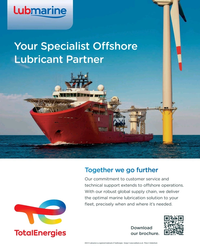 )
April 2024 - Maritime Reporter and Engineering News page: 3rd Cover
)
April 2024 - Maritime Reporter and Engineering News page: 3rd CoverYour Specialist Ofshore Lubricant Partner T Togeth her w we go o furt ther r Our commitment to customer service and technical support extends to ofshore operations. With our robust global supply chain, we deliver the optimal marine lubrication solution to your ?eet, precisely when and where it’s needed.
-
 )
April 2024 - Maritime Reporter and Engineering News page: 48
)
April 2024 - Maritime Reporter and Engineering News page: 48Index page MR Apr2024:MN INDEX PAGE 4/5/2024 1:33 PM Page 1 ANCHORS & CHAINS MILITARY SONAR SYSTEMS tel:+44 (0) 1752 723330, [email protected] , www.siliconsensing.com Anchor Marine & Supply, INC., 6545 Lindbergh Houston, Massa Products Corporation, 280 Lincoln Street, SONAR TRANSDUCERS
-
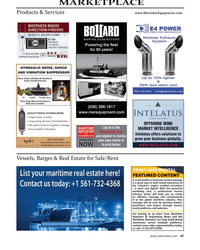 )
April 2024 - Maritime Reporter and Engineering News page: 47
)
April 2024 - Maritime Reporter and Engineering News page: 47MARKETPLACE Products & Services www.MaritimeEquipment.com Powering the fleet for 60 years! HYDRAULIC NOISE, SHOCK AND VIBRATION SUPPRESSOR Noise, Shock, VibraO on & PulsaO on in Quiet, Smooth Flow Out Oil Bladder Nitrogen (blue) Manufactured by MER
-
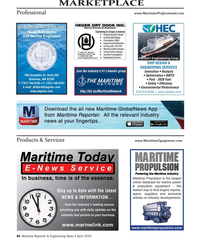 )
April 2024 - Maritime Reporter and Engineering News page: 46
)
April 2024 - Maritime Reporter and Engineering News page: 46MARKETPLACE Professional www.MaritimeProfessional.com GILBERT ASSOCIATES, INC.GILBERT ASSOCIATES, INC. Naval Architects and Marine Engineers SHIP DESIGN & ENGINEERING SERVICES Join the industry’s #1 Linkedin group )NNOVATION
-
 )
April 2024 - Maritime Reporter and Engineering News page: 43
)
April 2024 - Maritime Reporter and Engineering News page: 43“The industry is an ecosystem which includes owners, managers, mariners, shipyards, equipment makers, designers, research institutes and class societies: all of them are crucial,” – Eero Lehtovaara, Head of Regulatory & Public Affairs, ABB Marine & Ports All images courtesy ABB Marine and Ports provi
-
 )
April 2024 - Maritime Reporter and Engineering News page: 38
)
April 2024 - Maritime Reporter and Engineering News page: 38Tech Files Latest Products, Systems and Ship Designs Zero-Emission Mooring Service of a Tanker Consulmar achieved a milestone by executing what it calls ing boat Castalia, which operates on full electric propulsion. the world's ? rst zero-emissions mooring service for a tanker. Equipped with two 150 kW
-
 )
April 2024 - Maritime Reporter and Engineering News page: 28
)
April 2024 - Maritime Reporter and Engineering News page: 28FEATURE INTERVIEW track missiles and warheads for the Mis- sile Defense Agency, and it travels with its support ship, the MV Hercules. For our Service Support ships, we have the two hospital ships, USNS Mer- cy and Comfort; two rescue and salvage ships; two submarine tenders; and the Sixth Fleet ?
-
 )
April 2024 - Maritime Reporter and Engineering News page: 27
)
April 2024 - Maritime Reporter and Engineering News page: 27RADM PHILIP SOBECK, MILITARY SEALIFT COMMAND With COVID, we had to make some hard choices for our Do your CIVMARs have upward mobility? mariners because we couldn’t rotate. Many of our mariners The Navy has Sailors who become “Mustangs,” and work found other employment, and were able to use their skills
-
 )
April 2024 - Maritime Reporter and Engineering News page: 25
)
April 2024 - Maritime Reporter and Engineering News page: 25RADM PHILIP SOBECK, MILITARY SEALIFT COMMAND Photo by Brian Suriani USN Military Sealift Command From a global supply chain perspective, What makes MSC so vital to the we’ve learned a lot about dealing with Navy’s ? eet and our military disruptions. COVID delivered a big forces around the world? wake-up
-
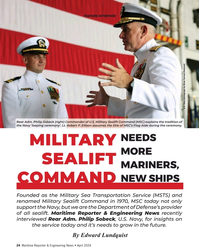 )
April 2024 - Maritime Reporter and Engineering News page: 24
)
April 2024 - Maritime Reporter and Engineering News page: 24FEATURE INTERVIEW U.S. Navy photograph by Brian Suriani/Released Rear Adm. Philip Sobeck (right) Commander of U.S. Military Sealift Command (MSC) explains the tradition of the Navy ‘looping ceremony’. Lt. Robert P. Ellison assumes the title of MSC’s Flag Aide during the ceremony. NEEDS MILITARY MORE
-
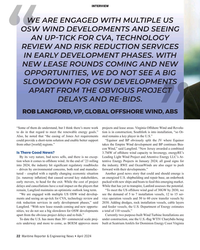 )
April 2024 - Maritime Reporter and Engineering News page: 22
)
April 2024 - Maritime Reporter and Engineering News page: 22INTERVIEW WE ARE ENGAGED WITH MULTIPLE US OSW WIND DEVELOPMENTS AND SEEING AN UP-TICK FOR CVA, TECHNOLOGY REVIEW AND RISK REDUCTION SERVICES IN EARLY DEVELOPMENT PHASES. WITH NEW LEASE ROUNDS COMING AND NEW OPPORTUNITIES, WE DO NOT SEE A BIG SLOWDOWN FOR OSW DEVELOPMENTS APART FROM THE OBVIOUS
-
 )
April 2024 - Maritime Reporter and Engineering News page: 21
)
April 2024 - Maritime Reporter and Engineering News page: 21ROB LANGFORD, VP, GLOBAL OFFSHORE WIND ob Langford has worked in the offshore industry ABS. “We are growing and evolving our services across all for more than three decades, ‘cutting his teeth’ offshore infrastructure along with our continued support to the in a UK design ? rm working in the North Sea
-
 )
April 2024 - Maritime Reporter and Engineering News page: 16
)
April 2024 - Maritime Reporter and Engineering News page: 16MARKETS SOVs – Analyzing Current, Future Demand Drivers By Philip Lewis, Director of Research, Intelatus © Björn Wylezich/AdobeStock t a high-level, there are three solutions to transferring Lower day rate CTVs are often used for daily transfer of technicians from shore bases to offshore wind farms
-
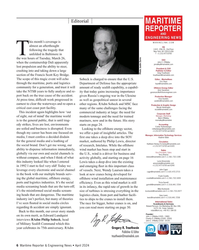 )
April 2024 - Maritime Reporter and Engineering News page: 6
)
April 2024 - Maritime Reporter and Engineering News page: 6Editorial MARITIME REPORTER AND ENGINEERING NEWS his month’s coverage is M A R I N E L I N K . C O M almost an afterthought HQ 118 E. 25th St., 2nd Floor following the tragedy that New York, NY 10010 USA T +1.212.477.6700 Tunfolded in Baltimore in the wee hours of Tuesday, March 26, CEO John C.
-
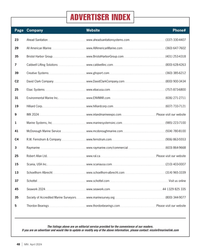 )
April 2024 - Marine News page: 48
)
April 2024 - Marine News page: 48ADVERTISER INDEX Page Company Website Phone# 23 Ahead Sanitation www.aheadsanitationsystems.com (337) 330-4407 29 All American Marine www.AllAmericanMarine.com (360) 647-7602 35 Bristol Harbor Group www.BristolHarborGroup.com (401) 253-4318 7 Caldwell Lifting Solutions www.caldwellinc.com (800)
-
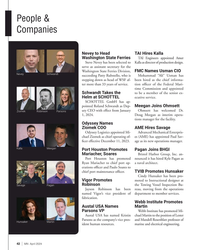 )
April 2024 - Marine News page: 42
)
April 2024 - Marine News page: 42People & Companies Nevey to Head TAI Hires Kalla Washington State Ferries TAI Engineers appointed Amer Steve Nevey has been selected to Kalla as director of production design. serve as assistant secretary for the FMC Names Usman CIO Washington State Ferries Division, Nevey Schwandt succeeding Patty
-
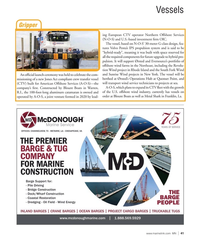 )
April 2024 - Marine News page: 41
)
April 2024 - Marine News page: 41Vessels Gripper ing European CTV operator Northern Offshore Services (N-O-S) and U.S.-based investment ? rm OIC. The vessel, based on N-O-S’ 30-meter G-class design, fea- tures Volvo Penta’s IPS propulsion system and is said to be “hybrid-ready”, meaning it was built with space reserved for all the
-
 )
April 2024 - Marine News page: 35
)
April 2024 - Marine News page: 35Capt. Josh Ferguson, master of the eWolf. Administration (MARAD), which all provided ? nancial support and other resources. “This tug becomes somewhat commercially viable be- cause of the grant process,” Manzi said. “Unlike a ferry service that’s paid for by tax dollars, we have to collect fares and
-
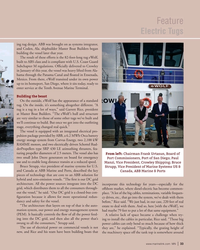 )
April 2024 - Marine News page: 33
)
April 2024 - Marine News page: 33Feature Electric Tugs ing tug design. ABB was brought on as systems integrator, and Coden, Ala. shipbuilder Master Boat Builders began building the vessel later that year. The result of these efforts is the 82-foot-long tug eWolf, built to ABS class and is compliant with U.S. Coast Guard Subchapter M
